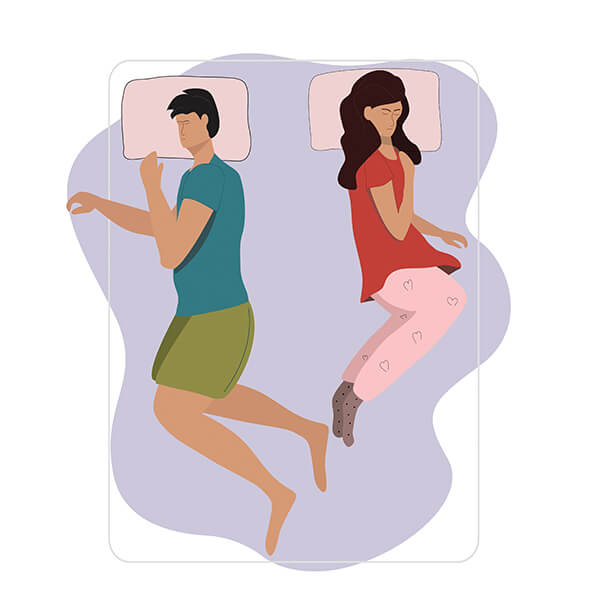
The Covid-19 pandemic played havoc with the quality of sleep for many Americans, significantly increasing the number of poor sleepers and inflicting mental, physical and financial strains on those poor sleepers, a new survey reveals.
The “State of America’s Sleep” survey, conducted by the Better Sleep Council, documents a country that is as divided in its sleep quality as it is in its politics.
The survey found that more Americans now are experiencing extremes in their sleep — on both the positive and negative sides of the spectrum, with few Americans in the middle.
It also revealed that the effects of the ongoing pandemic have heightened those sleep extremes.
“The ‘Divided States of America’ has always been a model for people’s health experiences, but this latest wave of research shows that this divide now characterizes how people are sleeping,” says Mary Helen Rogers, vice president of marketing and communications for the BSC, the consumer education arm of the International Sleep Products Association. “These findings are intriguing, and if our tips can help poor sleepers improve their sleep habits, then we’ll certainly make progress in closing this divide.”
Poor sleepers paid a price during the pandemic, the survey reveals, with 48% of those sleepers saying their mental/emotional health has declined over the past year, 40% saying their financial situation has changed negatively and 33% saying they have gotten less exercise.
Poor sleepers are more likely to wake up tired, stiff, in pain, sore, or not rested and refreshed. They are more likely to use sleep-promoting medication or other tools to help them sleep; 38% regularly sleep with a fan and are more likely to often/frequently use sleep-promoting over-the-counter or prescription medications to help them sleep than excellent sleepers.
“Considering these results, poor sleepers can learn a few tips from excellent sleepers,” Rogers says. “Even during the pandemic, the best sleepers in America are exercising regularly and enjoying it, are increasing their savings, and are having deep, meaningful relationships. They are succeeding at all of these things even in challenging times.”
The BSC launched The State of America’s Sleep in 2019 with the goal of measuring the quality of sleep in the country year over year. For the latest study, about 2,000 surveys were conducted in March 2021 among a representative sample of U.S. adults. The results are statistically significant, the BSC says.
The survey established a Sleep Index that can be used to track America’s sleep quality over time. The index takes the responses to two questions — one on how consumers say they slept within the past two weeks, and the other on how often consumers felt tired or rested when they awakened in the morning within the past two weeks — and scales a multiplicative index so that the average score is 100. That index is then used to create three groups of sleepers: Poor sleepers, average sleepers, and excellent sleepers.
The recent survey found that the numbers of both poor and excellent sleepers have increased since 2019. While 35% of consumers are now classified as excellent sleepers, that number has only increased by two percentage points since 2019. In contrast, the number of sleepers classified as poor sleepers has jumped by six percentage points from 2019 — to 62% this year.
“The research shows for the first time a dramatic dichotomy in how America is sleeping — with far more people reporting they’re sleeping poorly or sleeping excellently, and few people with average sleep quality,” Rogers says.
Excellent sleepers are more likely to be found in urban areas, to be older and to have a higher education. Their outlook is more positive, and they are more likely to feel good about the economy, think the country is moving in the right direction and be confident in the current administration.
Poor sleepers, on the other hand, are more likely to be found in rural areas. They are more likely to be younger and generally have less education. Their outlook is not as positive, and they are more likely to not feel good about the economy, to not think the country is moving in the right direction and to not be confident in the current administration.
As expected, poor sleepers struggle with sleep. They do not sleep enough, struggle to fall asleep, wake up frequently and cannot go back to sleep after waking up. Over two-thirds (70%) wake up tired, and over half (60%) say they rarely, if ever, wake up rested or refreshed. Although most people don’t use sleep-promoting medication or other tools to help them sleep, poor sleepers are more likely to do so than excellent sleepers.
Poor sleepers are more likely to have increased their screen time during the pandemic, as well as to have increased their alcohol consumption — both behaviors reflected in other research on the effects of the pandemic.
Although the research shows the depth of America’s sleep quality divide, it also suggests things poor sleepers can learn from excellent sleepers that would improve their sleep quality. Excellent sleepers have been participating in a variety of activities and continue to do so. They also are trying new activities and sticking with them. Excellent sleepers are exercising regularly and many have increased their exercise in the last year.
More than half (54%) of excellent sleepers have tried outdoor activities like hiking, bike riding and kayaking in the past year. And excellent sleepers are more likely to have been participating in gardening, meditation and yoga for more than a year.
Excellent sleepers are financial savers and have even significantly increased their savings since the Covid-19 pandemic hit, the survey found.
More than half of excellent sleepers (54%) saved money for vacations, up from 48% in 2020. And more than one-third (40%) of excellent sleepers invested in the stock market, compared to 34% in 2020.

